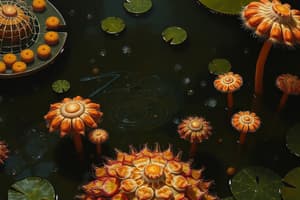Podcast
Questions and Answers
Which group of protists is known for being important in marine ecosystems and potentially causing red tides?
Which group of protists is known for being important in marine ecosystems and potentially causing red tides?
- Water Molds
- Amoebozoans
- Aveolates (correct)
- Diplomonads
What defines the characteristic feature of chloroplasts in the context of plants and algae?
What defines the characteristic feature of chloroplasts in the context of plants and algae?
- They are responsible for structural stability.
- They allow the conversion of CO2 and sunlight into energy. (correct)
- They aid in cellular respiration.
- They enable the production of DNA.
What type of algae is commercially important in products like toothpaste and ice cream?
What type of algae is commercially important in products like toothpaste and ice cream?
- Brown Algae
- Red Algae (correct)
- Blue-green Algae
- Green Algae
Which of the following statements about water molds is correct?
Which of the following statements about water molds is correct?
What defining feature does the group of plants known as 'plants' possess?
What defining feature does the group of plants known as 'plants' possess?
In the life cycle of Ulva, what distinct characteristic is notable?
In the life cycle of Ulva, what distinct characteristic is notable?
Which type of algae is commonly found in freshwater streams and ponds and has flagella?
Which type of algae is commonly found in freshwater streams and ponds and has flagella?
What characteristic do plants share that distinguishes them from protists?
What characteristic do plants share that distinguishes them from protists?
Which type of protist is considered the most ancient lineage and can cause illness in humans?
Which type of protist is considered the most ancient lineage and can cause illness in humans?
Which of the following is a plant characteristic not shared with most protists?
Which of the following is a plant characteristic not shared with most protists?
Flashcards
What are protists?
What are protists?
Protists are a diverse group of eukaryotic organisms that are not plants, animals, or fungi. They are often unicellular, but some are multicellular. Some protists are autotrophic (like algae) and can photosynthesize, while others are heterotrophic (like protozoans) and must consume other organisms for food.
What are diplomonads?
What are diplomonads?
Diplomonads are a group of protists that are considered to be among the most ancient lineages. They are characterized by having two nuclei and four flagella. Their mitochondria lack DNA.
What is Giardia?
What is Giardia?
Giardia is a genus of diplomonad protists that can cause intestinal illness in humans and other animals. Infection occurs when contaminated water is ingested.
What are aveolates?
What are aveolates?
Signup and view all the flashcards
What are water molds?
What are water molds?
Signup and view all the flashcards
What are amoebozoans?
What are amoebozoans?
Signup and view all the flashcards
What is the defining characteristic of plants and algae?
What is the defining characteristic of plants and algae?
Signup and view all the flashcards
What is photosynthesis?
What is photosynthesis?
Signup and view all the flashcards
What are red algae?
What are red algae?
Signup and view all the flashcards
What are green algae?
What are green algae?
Signup and view all the flashcards
Study Notes
Protists
- Some protists are autotrophic (photosynthetic) and some are heterotrophic (protozoans)
- Some protists, like Diplomonads, are considered ancient lineages
- Diplomonads have two nuclei, four flagella, and altered mitochondria
- Dinoflagellates are important in marine ecosystems and can cause red tide
- Water molds cause diseases, like the potato famine
- Amoebozoans move and feed using pseudopodia
Plants and Algae
- Chloroplasts define the group, resulting from endosymbiosis
- Most protists are autotrophic, using sunlight and CO2 to produce sugar (O2 and H2O are byproducts)
- Red algae contain pigments that mask chlorophyll, used in products like toothpaste, whipping cream
- Red algae are crucial to coral reefs
- Red algae are used for agar in labs & in nori for sushi
Green Algae
- Green algae show unicellular, colonial, and multicellular forms
- Chlamydomonas is a single-celled green algae common in freshwater
- Volvox is a colonial green algae, sometimes asexual or sexual
- Ulva (sea lettuce) is a multicellular green algae with a complex life cycle
Plants
- Plants are essential for life processes, such as food and oxygen production
- Plants stabilize soil, create habitats, and are aesthetically pleasing
- Plants are sessile (immobile), multicellular, and develop from embryos
- Plants primarily live on land, have cell walls, and chloroplasts
- Plants are autotrophs (photosynthesize)
- Photosynthesis converts sunlight, water, and CO2 to sugar as fuel
Plant Ancestors
- Plants evolved from green algae
- Bryophytes (mosses) are non-vascular plants, lack a true vascular system for transporting water and nutrients
Plant Types
- Seedless vascular plants (e.g., ferns) have vascular systems for nutrient and water transport, producing spores
- Seed plants (e.g., conifers) produce seeds instead of spores and do not need water for reproduction
- Angiosperms (flowering plants) have diverse species and are typically animal-pollinated
- Angiosperms have complex relationships with animals for pollination and seed dispersal
Studying That Suits You
Use AI to generate personalized quizzes and flashcards to suit your learning preferences.




